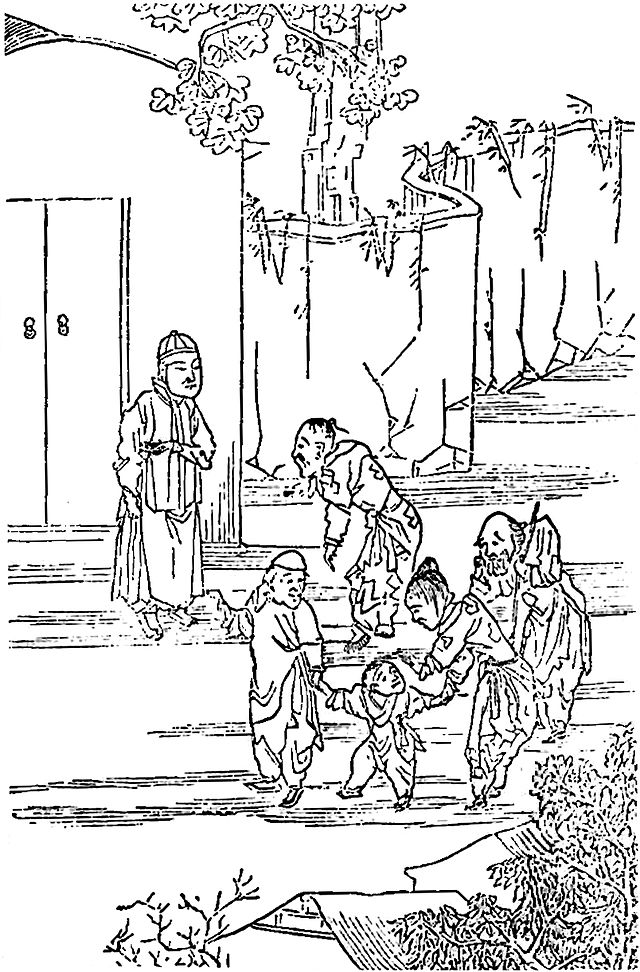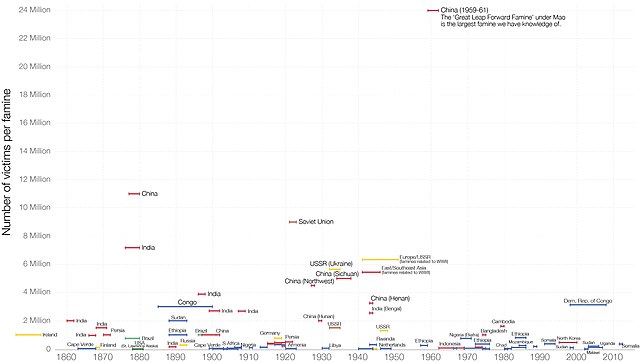| Name |
Time |
Region |
Context |
Estimated number of dead |
|---|
| Mid-Tang Famine |
714-719 |
|
Natural disasters, including a locust plague in 716. Tang Emperor Xuanzong subsequently instituted mandatory granary supplies and set fixed prices on grain. |
400,000 to over 1 million. |
| Xìngzhēn Disaster |
784-785 |
Northern China |
Devastating locust plague. |
Millions dead or displaced.[3] |
|
873–884 |
|
Drought, part of a broader climatic drying and cooling period, caused disastrous failures in crop harvest,[4] leading to famine and a peasant rebellion; Huang Chao captured capital |
Tens of thousands face starvation. |
| Chinese famine of 1333-1337 |
1333–1337[5] |
|
|
6 million[6] |
| Hongxi famine |
1425 |
|
|
| Jingtai Slough |
1440-1455[7] |
Zhejiang, Shanxi, Shaanxi, northern Jiangsu, Shandong |
Cold conditions |
|
|
1477-1487 |
|
Flooding of the Yellow River. |
|
| Hongzhi famine |
1494-1495 |
|
Persistent drought, followed by flooding in northern China and the collapse of the Shandong dam. Worsened by climatic shifts in the northern hemisphere.[8] |
|
|
1526 |
Beijing |
|
|
|
1543-1544 |
Zhejiang |
|
|
| Wanli Slough I |
1586-1589 |
|
Flooding followed by drought.[9] coinciding with La Niña climate disruption |
Most lethal famine of the 1500's |
| Wanli Slough II |
1615-1619 |
|
Drought, flood and sandstorms from deforestation. |
|
| Chongzhen drought |
1627–1644 |
Beijing, southern Hebei, northern Henan, and western Shandong, along the Yellow, Wei, and Fen rivers in Shaanxi and the Yangtze River delta. |
One of the most severe droughts in Chinese history, leading to the collapse of the Ming dynasty in 1644 |
2 million |
| Haizi famine |
1755–
1756 |
|
Drought and flood |
70% of the poorer farmers of Rugao county[10] |
|
1810–
1811 |
Hebei |
Flood |
11 million[11] |
| The Great Jiaqing Famine in Yunnan |
1815–
1817 |
Yunnan, with hunger in most of China |
Microthermal climate disaster tied to the eruption of the Tambola volcano[12] |
Tens to hundreds of thousands |
|
1846–
1851 |
Hebei, Zhejiang and Hubei |
Flood |
15 million
(45 million population decrease, with unknown proportion emigrating)[11] |
|
1857 |
|
Flooding in Hubei and Shandong, combined with instability due to the Taiping Rebellion and Nian Rebellion. |
8 million |
|
1851–1873 |
|
First Opium War, Treaty of Nanjing,[13] Nian Rebellion, Taiping Rebellion, flooding in 1863 and 1867, as well as drought. |
10–30 million people[14][15] |
| Northern Chinese Famine of 1876–79 |
1876–
1879 |
Mostly Shanxi (5.5 million dead), also in Zhili (2.5 million), Henan (1 million), Shaanxi and Shandong (0.5 million).[16] |
Drought, decades of declining grain production relative to population size.[17] |
9.5 to 13 million[18] |
| Northern Chinese Famine of 1901 |
1901 |
Shanxi, Shaanxi, Inner Mongolia |
The drought from 1898-1901 led to a fear of famine, which was a leading cause of Boxer Rebellion. The famine eventually came in Spring 1901.[19] |
0.2 million in Shanxi, the worst hit province. |
| Chinese famine of 1906–1907 |
1906-07 |
northern Anhui, northern Jiangsu |
|
20 to 25 million [20] |
| Chinese famine of 1920-1921 |
1920–1921 |
Henan, Shandong, Shanxi, Shaanxi, southern Zhili (Hebei) |
|
0.5 million[21] |
| Chinese famine of 1928–30 |
1928–1930 |
Northern China |
Drought, wartime constraints, and inefficiency of relief[22] |
6 to 10 million [23] |
| Sichuan famine of 1936-37 |
1936-1937 |
Sichuan, Henan and Gansu |
Drought and civil war. |
5 million in Sichuan,[24][25] up to 50 million displaced as 'famine refugees' |
| 1942–1943 famine |
1942–1943 |
Mainly Henan |
Second Sino-Japanese War |
0.7 to 1 million[26] |
| Great Chinese Famine |
1959–1961[27] |
Half of the country, in particular Anhui (18% died), Chongqing (15% died), Sichuan (13% died), Guizhou (11% died), Hunan (8% died)[28] |
Great Leap Forward, Floods, Droughts, Typhoons, Insect Invasion[29] |
15 to 55 million[30][28][31] |



